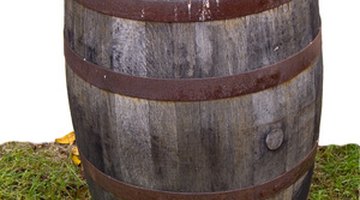How do I Put Foam in Plastic Barrels to Float Them?
Filling a plastic barrel with expanding urethane foam will produce a highly buoyant float which may be left in contact with water for weeks or even months at a time. Such a barrel is ideal for making a do-it-yourself floating dock, buoy, party barge or flotation aid for use on a lake or pond.

This process is explicitly for filling a single barrel with foam, but may be expanded for making many floating barrels simultaneously via the use of larger batches of foam.
Things You Will Need
- 55-gallon open-head plastic drum
- 16 pounds of urethane foam (2-pounds density)
- Bucket
- Paint stir
- Epoxy
- Silicone sealant
Warning
Fill the barrel in a well-ventilated area, as it releases carbon dioxide while expanding.
The urethane foam will stick to almost anything and is designed to be completely resistant to solvents, so cover up anything you don't want to be damaged.
Ideally, the temperature should be around 80 degrees Fahrenheit for the foam to fully expand. Lower temperatures will result in reduced rates of expansion.
-
Remove the top of the 55-gallon drum.
-
Following the specific instructions on the container of urethane foam, mix the two components in a bucket and pour the foam into the open plastic drum. If more than one batch of foam is required, wait 15 to 20 minutes in between batches to ensure good adhesion. The volume of a 55-gallon drum is approximately 7.4 cubic feet, so use an amount of foam that will fill that volume (a 16-pounds kit for 2-pounds density foam).
-
Wait one hour after the barrel has been filled with foam. Make a bead of epoxy around the lip of the plastic drum where the top will make contact it. Place the top back onto the drum, gluing it in place.
-
Seal the lip of the drum where the top attaches to it with silicone sealant. Keeping water from coming into contact with the urethane foam will help extend the period of time the drum may be in the water from several weeks or months to a practically indefinite period of time, as long as the seal holds.
The Drip Cap
- Filling a plastic barrel with expanding urethane foam will produce a highly buoyant float which may be left in contact with water for weeks or even months at a time.
- Seal the lip of the drum where the top attaches to it with silicone sealant.
- Keeping water from coming into contact with the urethane foam will help extend the period of time the drum may be in the water from several weeks or months to a practically indefinite period of time, as long as the seal holds.
References
Resources
Writer Bio
Paul Bragulla began writing professionally in 2010, producing online articles. His experience as a researcher in beamed energy propulsion means that he can write knowledgeably about topics such as optics, laser operation and high-speed photography. Bragulla holds a Bachelor of Science in physics from Rensselaer Polytechnic Institute.
Photo Credits
- barrel image by Andrew Kazmierski from Fotolia.com
- barrel image by Andrew Kazmierski from Fotolia.com
More Articles



